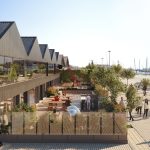Lilases – Boutique House & Garden : An exquisite manor house experience in Portugal’s Alentejo
You couldn’t have made it up. We are on our way to Portugal’s Alentejo region to visit a charming boutique hotel in the picture postcard village of Mora when the car breaks down.
Despite the time of year – September is drawing to its close — a ferocious and punishing sun is beating down mercilessly, subjecting scorching temperatures of over 30º on the vehicle which unfortunately happens to be black. Worrying if we have enough water, we abandon the car and seek shelter at the side of the road under the only obliging tree within walking distance.
A well-dressed woman emerges from her house, crosses her front yard dodging chickens and a couple of dogs, and appears at the gate to investigate. No “good afternoon” or “do you need help?”. Instead, she eyes us suspiciously and vanishes back into her house. We are alone!
A call is made and within 15 minutes a jovial and chatty man arrives to save the day and take us on to our destination — the Lilases Boutique House & Garden. He introduces himself as Rui de Sousa and he is the proprietor of this hidden gem nestled in the heart of the sleepy Alentejo countryside.
We drive through Mora, a lovely village not far from the historic city of Évora – a UNESCO World Heritage site. White houses with window ledges and door frames outlined in cheerful blue and yellow line the cobbled streets.
A bell rings one solitary chime from the local church in the empty square. The locals know that in this heat only mad dogs and Englishmen venture out in the sun at this time of day. I would plead guilty to the latter case. We pass the art museum with a banner advertising an exhibition. We are informed that this pertains to the long deceased locally famous neorealist artist Manuel Ribeiro de Paiva to whom a museum in the next village is dedicated to his work portraying the traditional and hard local peasant life in the first half of the last century.
A classical inspiration
The front of the actual house is nothing to write home about at first sight from the outside – a low rectangular building in white with linear details and the frames of eight large windows picked out in yellow. But do not let this deceive you, for the elegant beauty of this late XIX century mansion lies within and on the rear side of the façade.
Inside, the lofty reception rooms are lined from floor to ceiling with what appears to be oak panelling — much of it is rather cleverly hand-painted trompe l’oeil — broken up here and there by frescos with renaissance scenes of playful classical figures. The cream lounge walls are inset with marbled dusky pink ovals with similar classical Roman scenes and garlands giving a distinct feel of an XVIII century neo-classical interior. Comfortable cream sofas offset by pink cushions are dotted around the room between potted palms.
Invited to take a cooling drink and some regional ‘petiscos’ or snacks comprising home-made black pork pies with crackling on the elongated glazed veranda, en route we pass the ‘Four Seasons Room’, a panelled meeting room with shimmering honey silk wallpaper dominated by a long table illuminated by a large chandelier, perfect for business meetings and presentations.
But the piece de resistance of these ground floor rooms is this covered veranda with black, grey and white floor tiles, marble tables and white chairs which lend a certain Edwardian elegance to the scene and is immediately evocative of the legendary Café Parisien on Cunard’s famous liners RMS ‘Olympic’ and ‘Titanic’.
Large glass sliding doors open out onto the terrace below with a swimming pool guarded by recliners nestled within a beautiful garden filled with fragrant herbs, olive, orange and lemon trees, and a riot of bougainvillea. A wooden pergola is enveloped by lilac wisteria. The perfect place to enjoy a refreshing drink in the lazy late afternoons.
Gazing out beyond the orange rooftops of the neatly tended houses of the town that cascade down either side of this idyllic picture, an unimpeded landscape of vineyards and fields interrupted only by a river which, we are told, attracts local, national and international fishing enthusiasts, completes this delightful bucolic scene.
But it is at dusk over dinner that this painterly landscape takes on a magic of its own. The sky is splashed with a palette of burnt oranges, vibrant reds and deep mauves as the sun drops down casting a gentle radiance over the town, making you feel that you part of a masterpiece by Heade or Church.
The Alentejo – a slower pace of life
Our host Rui de Sousa is an interesting man with a fascinating national and international career in the hotel and hospitality industry until he decided to lovingly restore this mansion that was built in 1898 by an aristocratic agricultural landowner.
Starting his career in 1986 at the Meridien Hotel in Lisbon, he then opened the Penha Longa Resort in Sintra-Cascais Natural Park where he worked for 10 years before moving on to the Ritz Four Seasons, again in the Portuguese capital, before working abroad.
Rui opened two hotels in Egypt (Cairo and Sharm El Sheikh), managed a hotel on the Caribbean Island of St. Nevis, and managed another in London’s Canary Wharf. He returned to Lisbon where he spent 12 years in management for the Tivoli chain of hotels and was responsible for putting in the famous sky bars inspired by an example he had seen in Moscow.
“This place is really special”, he ponders. “I love the Alentejo way of life, and I strongly believe this region has a lot of potential and that within 10 years is going to be one of the most popular rural tourism destinations in Europe”, he says.
“The way of life, the culture, and cuisine is an inspiration for me, and I believe this project is one of many that I will do in the Alentejo. We have recreated a manor house with modern comforts and old-fashioned service”, he explains at dinner as we are served up the most tantalising regional cuisine served by local chef Dona Maria José.
During our brief stay we are treated to toasts topped with egg, local cheese, honey, wild mushrooms and cured ham sprinkled with local herbs curated from the hotel’s herb garden, or omelettes cooked to perfection served with local bacon, asparagus and mushrooms.
At lunch a homemade gazpacho soup Alentejo-style is served, laced with garlic, local tomatoes, green peppers, cucumber, coriander and fresh oregano, perfect for the hazy summer months.
Dinner surprised with a mouth-melting tender casserole of cheeks of pork in a rich sauce on a bed of creamy mashed potatoes, topped with glazed onions.
All meals are paired with superb Alentejo wines: Vinha d’Ervideira (Antão Vaz), Herdade das Servas from Estremoz, and Porta da Ravessa (all whites), or a rich and aromatic 2015 Mouchão, and a Vidigueira (both reds).
Everything is sourced locally, including the honey that comes a local apiary; the bread is baked at a bakery in the town, the cheeses too are from the area. “The original landowning family was the biggest employer in the town and in our own small way we’ve kept up that tradition of bringing local produce to the table, not only because it provides a touch of authenticity, but also because it helps the local economy”, explains Rui.
Out and about
And there are certainly things to do, see and visit within the environs. We were whisked off to try our hand at pottery making at the Brotas Pottery Works, – heaps of fun, but I won’t give up the day job — which is run by artisan ceramic maker José Carlos Lourenço Ramalhão whose pieces are all painted and decorated by hand with colourful and vivid scenes of traditional Alentejo agricultural life. You can pick up some lovely fruit platters, bowls, jugs, and mugs at a fraction of the price paid in souvenir shops in Lisbon. I picked up two salvers for €40. Like so much in this hotel that values local production, the pottery works also supplies customised earthenware pots from which are served hearty and warming stews and soups.
Alternatively, you can simply explore the town which dates to 1293, or if a spot of bathing floats your boat you can head down to the crystal waters of the river beach within the Gameiro Ecological Park nearby at Cabeção. Don’t forget to take your towels and plenty of sunscreen, while Lilases will be happy to prepare a picnic.
The park is located just 5 km drive from Mora and after a cooling swim you can take a walk along the 1.5 km stretch of wooden decked walkway that winds through stunning landscapes where nothing separates you from the stillness of nature broken only by the shrill twitters of soaring swallows.
Some 15 km further takes you to the charming village of Paiva that is rich with over 200 prehistoric monuments including Stone Age funerary megaliths. You can visit the 17th century St. Dinis Chapel within one of the most important dolmens on the Iberian Peninsula. These vertical monoliths form the walls of the chapel with a large slab of stone making the roof. The altar is covered in beautiful hand-painted Lisbon tiles dating from the XVIIIth century.
Rooms with a view
Chatting into the wee hours it was inevitably time to turn in after a lovely day experiencing the slow and relaxed pace of Alentejo life and hospitality, lulled to sleep by the sounds of crickets and the distant chime of the church bell.
The rooms dominated by high doors and elegant interiors are arranged on three very different floors, each presenting unique characteristics and charms. The lower floor features rooms with vaulted ceilings and balconies with sublime views over the Alentejo plains.
Large windows, with wooden shutters painted with Victorian frescoes and an extremely high ceiling mark the architecture of the ground floor. While the mansard floor, below the roof, features four cosy bedrooms with breathtaking views over the plains.
Located on the first floor under the mansard roof are 20 m2 rooms each with a balcony that is an authentic viewpoint over the surrounding countryside and the almond orchard. Airy and filled with light, for those who like to wake up at sunrise, these rooms are equipped with large and comfortable double beds that provide a unique and memorable sleeping experience.
Each of the rooms were designed and equipped to provide guests with an experience in which time has its own dimension, combined with the comfort, serenity and tranquility that make Lilases Boutique House & Garden a unique and privileged place.
Oh, and don’t bother to set your alarm. You won’t need it. The local cockerels do a great job. Well, we are in the countryside, after all!
Text: Chris Graeme Photos: Supplied










